9 – In your dreams
A comprehensive look at the identification of Marsh, Blyth’s Reed, Eurasian Reed, Melodious and Icterine Warblers
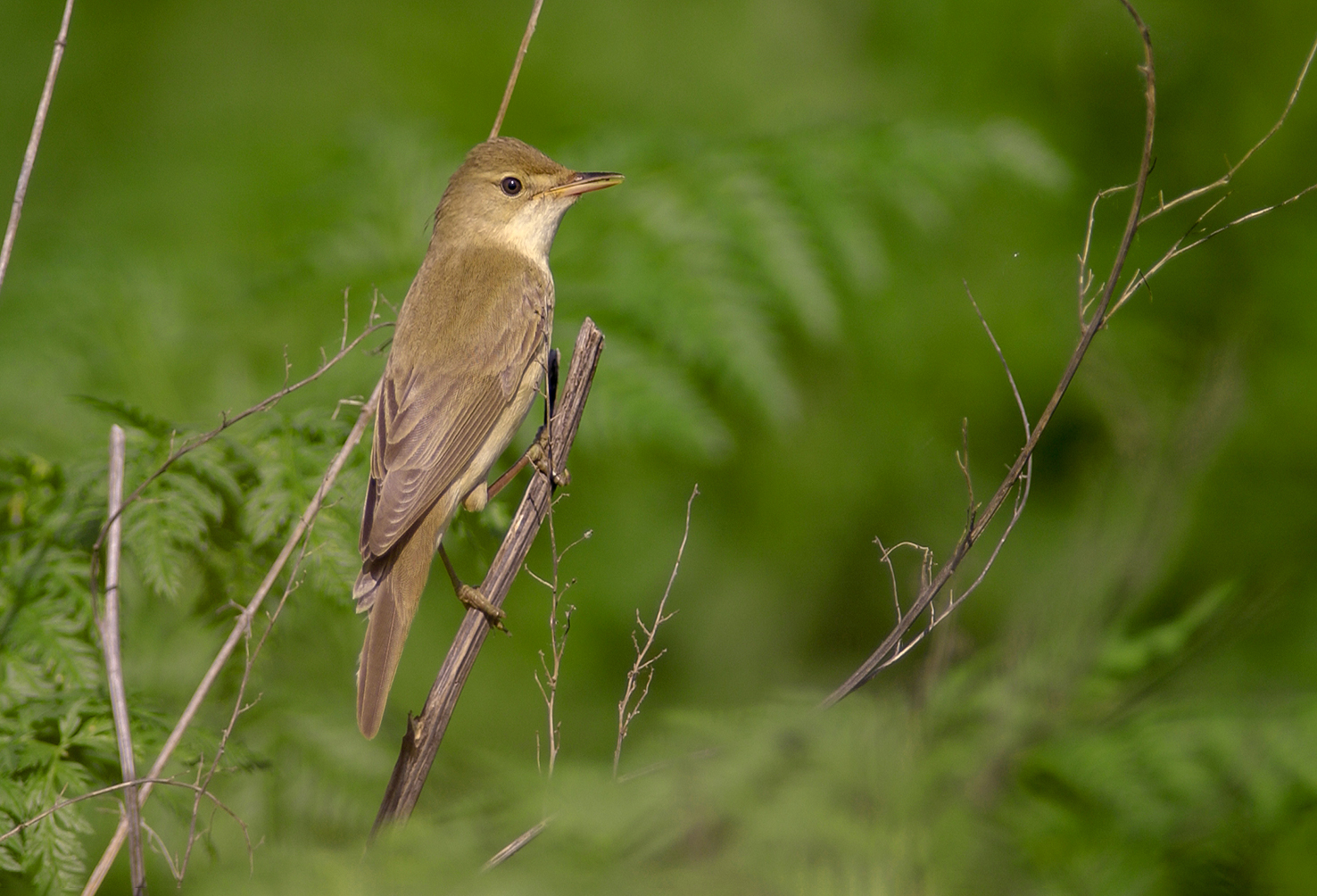
Marsh Warbler Acrocephalus palustris Pripyat, Belarus, 27 May 2003 (René Pop).
In a dream I am in Wareham, Dorset, birding with my normal bins, but it feels like the Middle Ages because the place is just an endless marsh with a nondescript huddle of monastic buildings and a church in the middle: St Mary’s. A few monks are tending garlic. My dress and bins don’t seem strange as I listen to their conversation about a parishioner who has malaria (“the ague” they call it). They are obviously worried about this disease that plagues them. I turn around and I am in the present. It’s the age of covid and as I walk past the graveyard, masked gentlefolk are waiting in cars for me to pass or turning into the lych gate to avoid me, all keeping themselves to themselves. I get the impression that they are waiting for the pandemic to pass them over. In typical dream fashion I am listening to the outdoor Sunday school as the teacher tells the children about the Hebrews’ escape from slavery in Egypt and the passing over or sparing of the firstborn of the Israelites on the eve of the exodus… The words “smote the land of Egypt” are filling my head as I turn past the southern corner of the ancient walls and out into the marsh.
It doesn’t seem at all unusual for Peter Moore to be there. After all, it’s his patch. He waves me over and gestures for me to listen. There’s an unusual warbler singing that he has picked up some distance from the path. The story of the exodus falls away and I listen for a few minutes. It sings at speed, one piece of mimicry after another followed by “the distinctive za wee” that according to Palmér & Boswall (1973) was “said never to be absent from a song of any duration”. I am reminded of my only safari in Kruger National Park, South Africa, where I spent an idyllic afternoon outside my lodge listening to the song of Dryoscopus cubla, the Black-backed or Southern Puffback that Françoise Dowsett-Lemaire in her famous paper (1979) said was always imitated by Marsh Warbler.
I say, “What do you think?”
Peter says, “Sounds like a Marsh Warbler to me”…
“And me,” I say. “It’s probably from Holland… they have nearly 100 000 pairs there so can spare us the odd bird”.
In the dream the sun is shining and the glory of the moment is brilliant…
I wake up at 04:45, and that early morning dread fills me as I remember that we are 60 shitty days into isolation, deep into sorting out the latest challenging aspect of chaos caused by covid. I struggle past the dream to remember last night and the message relayed from Peter Moore. He had been on his government-prescribed one hour walk when he made this phone recording… The message was accompanied by a short and very unclear recording of a song from the marsh just behind the church at Wareham. Not quite long enough for an easy identification, and without those ubiquitous Black-backed Puffback notes. Last night’s phone conversation with Paul Morton comes to mind. He isn’t sure he can exclude an Icterine Hippolais icterina or Blyth’s Reed Warbler Acrocephalus dumetorum. He had phoned Magnus who was in the middle of a FaceTime conversation with me. Magnus reserved judgement because of the poor recording.
Mo and I would have gone but we hadn’t been out of quarantine even once, and this was most definitely against the rules, so not the moment… I thought to myself that this is not the way it’s supposed to be! It would be a new bird for our Poole Harbour list! Not good for my mental health. I need a safe space where no one tells me bird news until I am ready to go out.
Both in and out of our dreams, marshes have plenty of identification challenges for birders, especially when they are full of little brown jobs. Look at these three plates made in a collaboration between Killian Mullarney and wildlife illustrator Richard Johnson and showing the fine details required to visually separate Eurasian Reed Warbler A scirpaceus, Marsh Warbler A palustris and Blyth’s Reed Warbler in the field. With eight to ten figures per plate, it’s good to get such an in-depth look. The Collins bird guide (Svensson et al 2009) has three figures for each, and most other guides one or two. To the untrained eye they look very much alike.
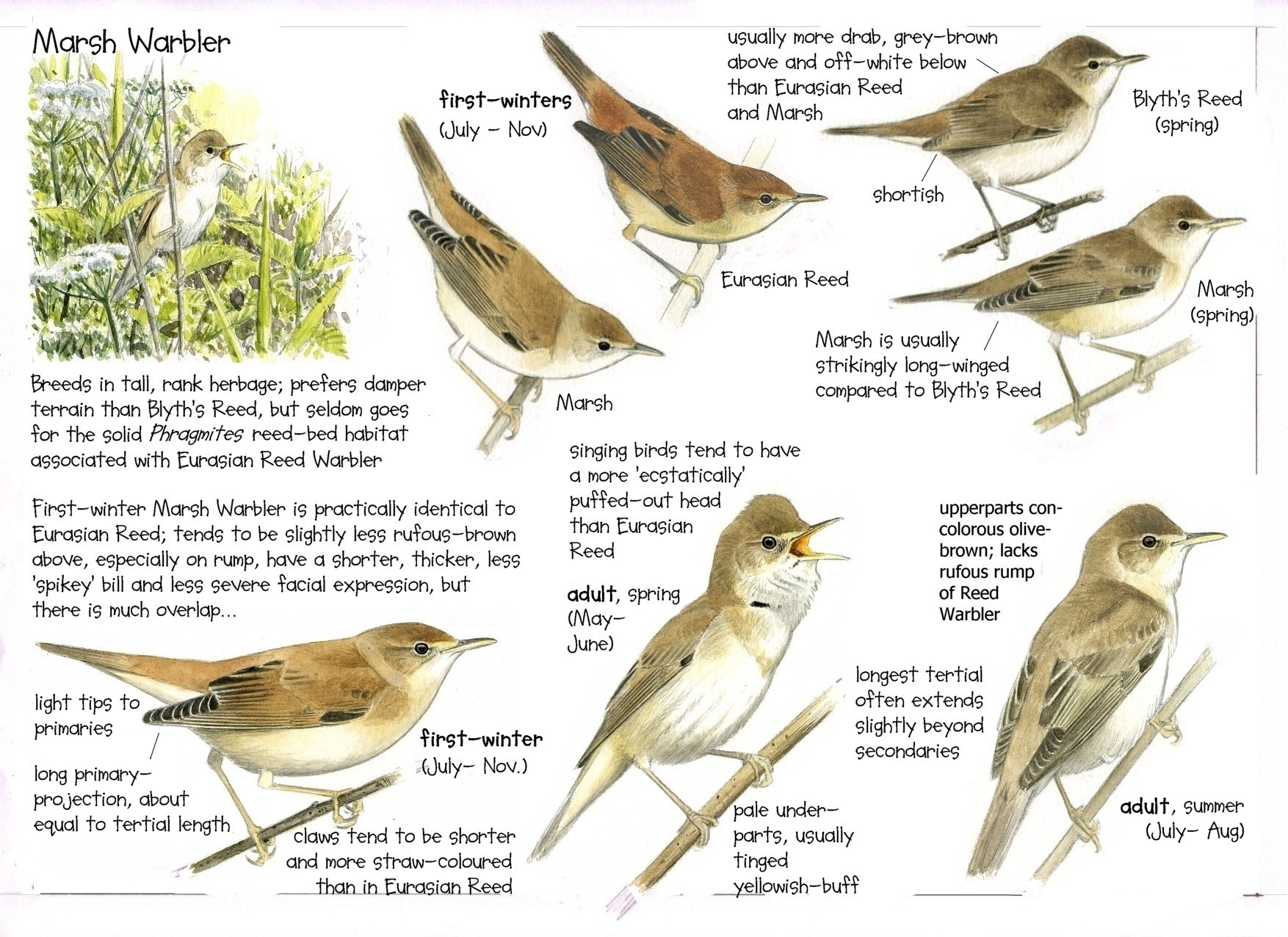
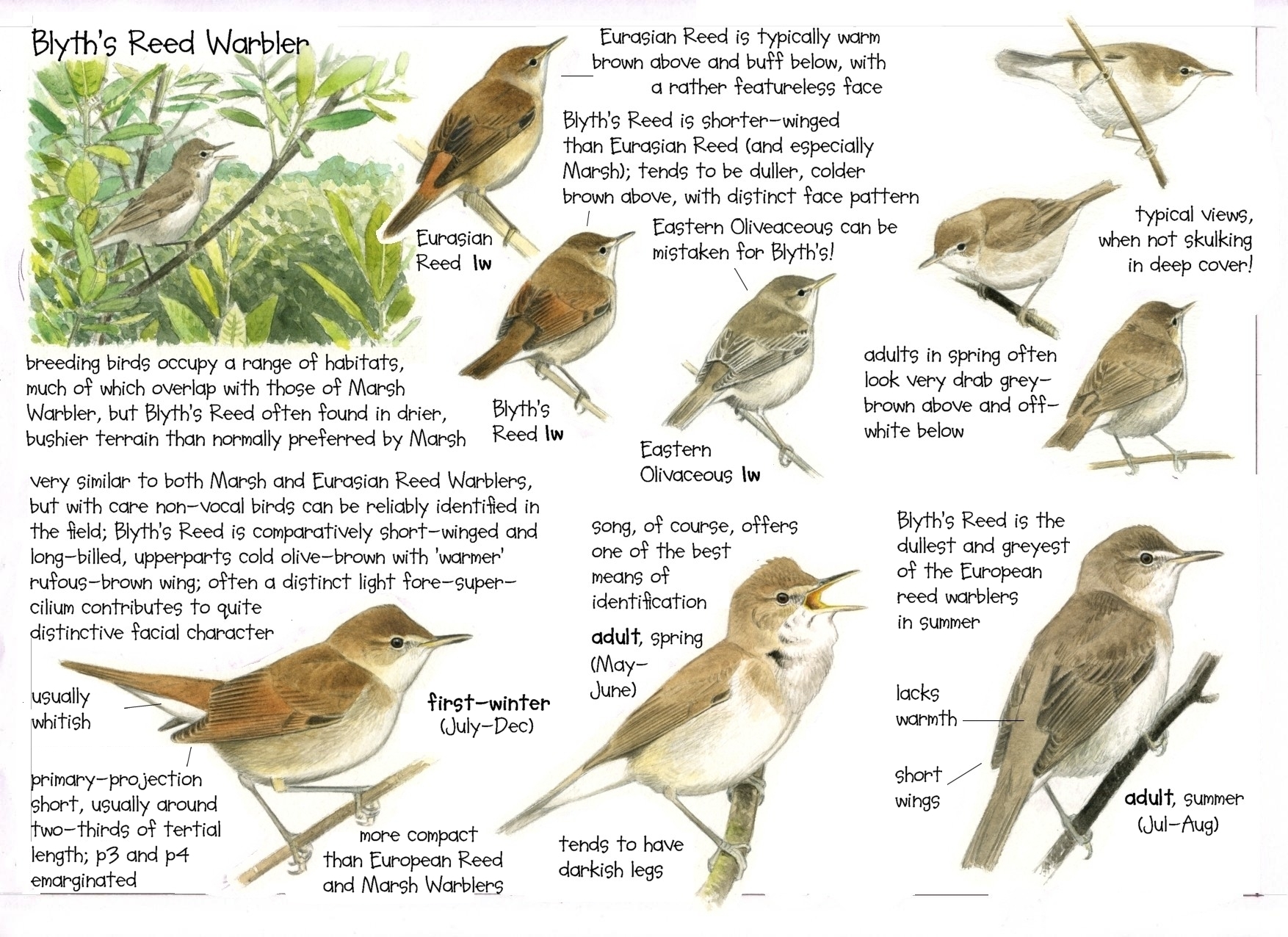
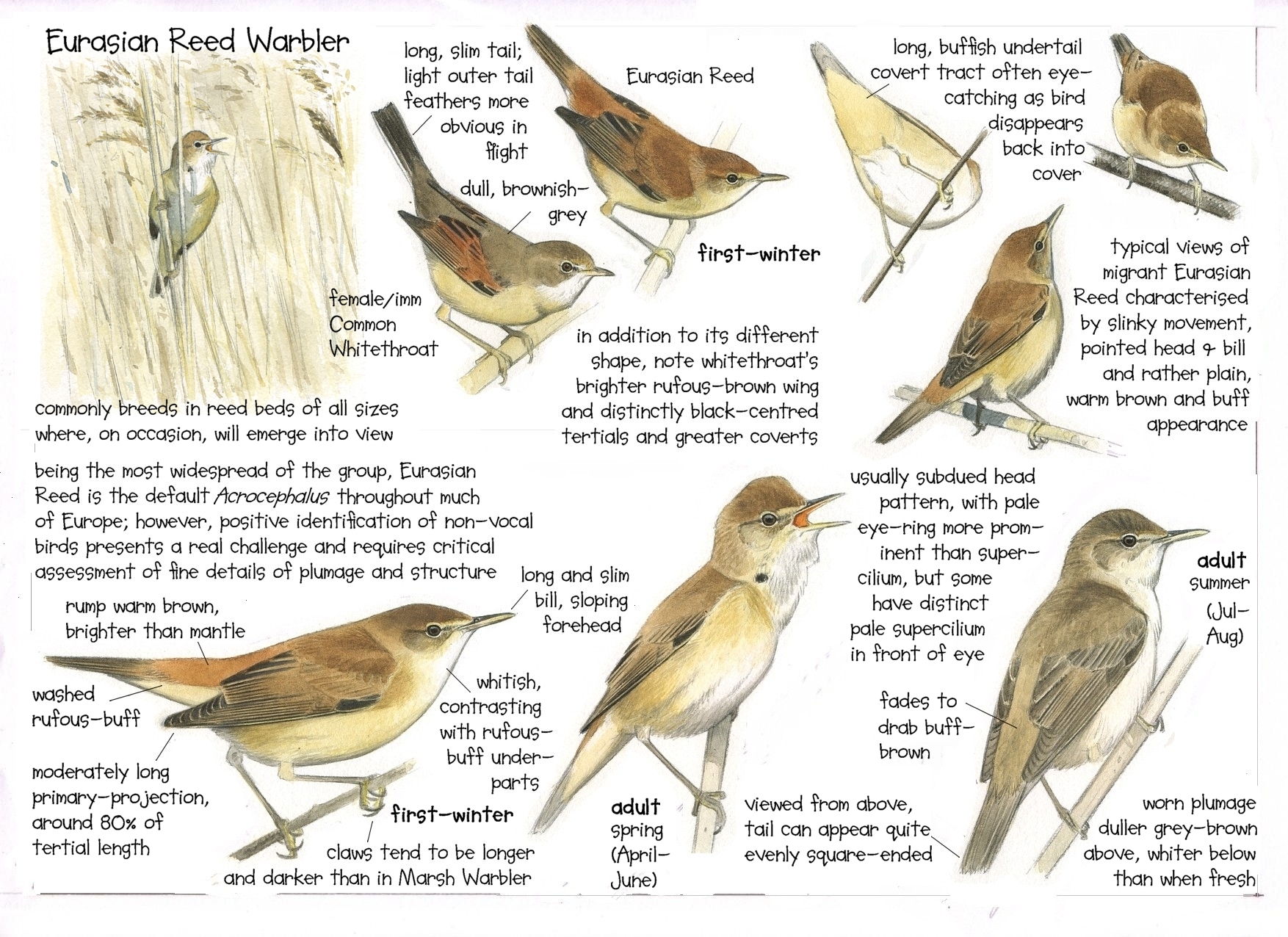
These three species are a favourite for identification articles, so we thought we would have a go. After all, they are very distinctive when you listen to each one in turn.
Marsh Warbler
Starting with Marsh Warbler’s main song, we were just going to borrow from Richard Hell and The Voidoids and say that to sum it up, the song of an adult Marsh Warbler ‘Comes in Spurts’.
We can do better than that though. Listen to this typical adult Marsh Warbler song on territory. It appears to be changing randomly between slow, often accelerating repetitions of a single sound, brief moments of stability where two sounds alternate rapidly, and wild outbursts of varied sounds. Now listen more carefully; there is more structure to it than that. Magnus analysed songs from 15 different individuals and it became clear that the changes in velocity follow a cyclical pattern.
Marsh Warbler Acrocephalus palustris Polder Achteraf, Noord-Holland, Netherlands, 04:56, 13 June 2006 (Magnus Robb). Song at close range. Background: Greylag Goose Anser anser, Common Cuckoo Cuculus canorus, Spotted Crake Porzana porzana, Carrion Crow Corvus corone, Savi’s Warbler Locustella luscinioides and Sedge Warbler A schoenobaenus. 060613.MR.45557.01
Four times a minute, on average, a male will go from slow repetitions of a single sound, or at least a single imitated species, through faster motifs usually alternating between two or more sounds, to a frenetic outburst. Hearing 15 seconds of a song, you can be fairly confident that a Marsh Warbler will, at some point, ‘go bonkers’! That’s one reason why when you only get a shorter sequence to listen to on a phone it can be quite difficult to call.
The most clearly structured Marsh Warbler songs are those performed at night when song is their focus. If you only consider the overall speed, the slower sections of a Marsh Warblers song could be confused with Blyth’s Reed Warbler, but not if there are faster outbursts several times a minute. Even if they are rather muted, the changes of speed are a diagnostic habit of Marsh Warbler.
Marsh Warbler Acrocephalus palustris Schokland, Flevoland, Netherlands, 03:00, 12 June 2011 (Arnoud B van den Berg). Slower, more clearly structured nocturnal song. Background: Garganey Spatula querquedula, Spotted Crake Porzana porzana, Baillon’s Crake Zapornia pusilla and Eurasian Reed Warbler A scirpaceus. 110612.AB.030056.01
Now let’s listen to the za wee za wee za wee sounds. The original idea suggested in the seminal Dowsett-Lemaire paper I have held dear for so long was that in 100% of songs there was puffback mimicry. Roberts’ Birds of Southern Africa describes the song of Black-backed (Southern) Puffback as chick weeu chick weeu chick weeu repeated up to 60 times. I have to admit that when I listened to the puffback’s endless singing while sitting outside my lodge in Kruger National Park I knew something wasn’t quite right. I thought at the time that it was one of Marsh Warbler’s worst impersonations. Thinking about it now I realise that I had jumped to a series of conclusions. First, why wouldn’t it be an accurate imitation? Marsh Warblers do perfect impersonations of everything else. Second, did Dowsett-Lemaire’s paper really say that za wee was the sound. Well, no, reading it again she quoted Walpole-Bond (1933) who first noted the motif and then Palmér & Boswall (1972) who illustrated precisely the exact sound. Then she identified that “It appears, in fact, to be an imitation of one of the calls of the Southern Puffback Dryoscopus cubla, an extremely noisy bushshrike, imitated in 100% of the repertoires”.
Some years ago when I attended a lecture by Clive Catchpole at the British library he explained to me that bird songs aren’t just representations of DNA, nor are they purely learnt. He explained that what’s inherited is the pattern, like a template that the bird likes to match what it has learnt to. While I have asked the same question many times since, it is this to which I return.
I have thought for some time that Marsh Warbler’s scolding za wee za wee is its key template that it just can’t resist using. Magnus however sees this as just one variant fitting a broader template, the alternation of two contrasting sounds. The first sound, he explained, was usually longer and more tonal and the second shorter and noisier. “The more tonal sound often sweeps upwards or downwards, or both, in what classical musicians call a ‘glissando’”.
“So not a puffback” I asked? “Well, Black-backed Puffback’s song fits the template and I’ve heard them steal it sometimes, but more often than not the two contrasting sounds come from completely different species. The combination might sound like witchou, witchou or chi-wang, chi-wang or a rapid tak-weep, tak-weep. Such two-part, rapidly repeated figures are so characteristic of Marsh Warbler that you rarely have to listen for more than a few seconds to hear one.” “In the cycle of song velocity,” he added, “they appear from when the song is somewhere between half and maximum velocity.”
Marsh Warbler Acrocephalus palustris Polder Achteraf, Noord-Holland, Netherlands, 04:56, 13 June 2006 (Magnus Robb). Za-wee variations: at the start is an imitation of Black-backed Puffback Dryoscopus cubla. There are several other za-wee-type motifs including, at 0:16-0:17, a slower one possibly combining Common Tern Sterna hirundo and Red-backed Shrike Lanius collurio. Background: Greylag Goose Anser anser, Common Cuckoo Cuculus canorus, Spotted Crake Porzana porzana, Carrion Crow Corvus corone, Savi’s Warbler Locustella luscinioides and Sedge Warbler A schoenobaenus. 060613.MR.45557.01
Vinaceous Dove Streptopelia vinacea Mole National Park, Savannah region, Ghana, 08:23, 11 November 2019 (Magnus Robb). Flight calls of a pair, with song in the background. Background: Yellow-breasted Apalis Apalis flavida. 191111.MR.082330.01
Marsh Warbler Acrocephalus palustris Polder Achteraf, Noord-Holland, Netherlands, 04:56, 13 June 2006 (Magnus Robb). Song at close range, starting with mimicry of Vinaceous Dove Streptopelia vinace. Background: Greylag Goose Anser anser, Common Cuckoo Cuculus canorus, Spotted Crake Porzana porzana, Carrion Crow Corvus corone, Savi’s Warbler Locustella luscinioides and Sedge Warbler A schoenobaenus. 060613.MR.45557.01
Another exotic sound very frequently mimicked is Blue-cheeked Bee-eater Merops persicus, often in combination with some other species as part of a rapid two-note alternation. In the following excerpt you can hear this at 0:22-0:23 and 0:38. Other aspects of Marsh Warbler mimicry are that it often groups together quite different sounds from a single species, eg, high-pitched soliciting with chattering of Marsh Harrier Circus aeruginosus (0:01-0:06), and that they can make transitions, associating similar species, eg, European Goldfinch Carduelis carduelis and Common Linnet Linaria cannabina (0:48-0:52). There are also imitations of, eg, Great Spotted Woodpecker Dendrocopos major, Western Jackdaw Corvus monedula, Barn Swallow Hirundo rustica, Blue-headed Wagtail Motacilla flava and Tree Pipit Anthus trivialis. Can you find them?
Marsh Warbler Acrocephalus palustris Schokland, Flevoland, Netherlands, 03:00, 12 June 2011 (Arnoud B van den Berg). Nocturnal song including many imitations of other species. Background: Garganey Spatula querquedula, Spotted Crake Porzana porzana, Baillon’s Crake Zapornia pusilla and Eurasian Reed Warbler A scirpaceus.
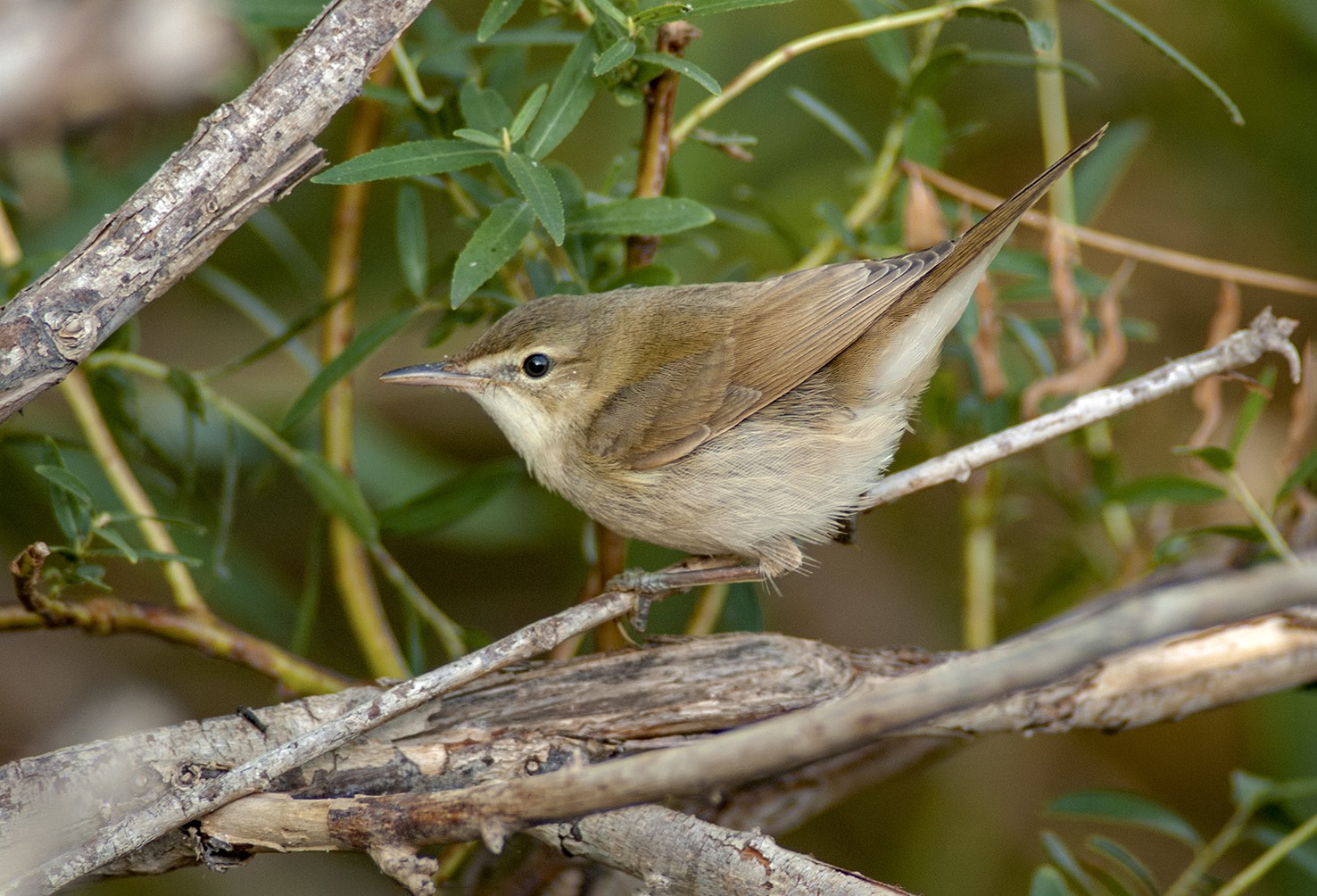
Blyth’s Reed Warbler Acrocephalus dumetorum Kyzyl-Kol, Zhanatas, Kazakhstan, 10 September 2009 (René Pop).
Blyth’s Reed Warbler
Finnish birders have a simple test to separate Blyth’s Reed Warbler from Marsh Warbler. If they can name the bird being imitated it’s a Blyth’s Reed, but if they are tripping over their tongue because the imitations are delivered so fast and changed so frequently it’s a Marsh. Returning to lyrics of contemporary songs I imagine that if a Blyth’s Reed was talking to a Marsh Warbler it would explain its style a bit like Leonard Cohen’s in his lyrics for Slow.
I always liked it slow
I never liked it fast
with you it’s got to go
with me it’s got to last
When a Blyth’s Reed Warbler sings on its breeding territory, the song has a steady pace and sounds relatively slow. It contains plenty of mimicry, but imitates a given species at length, giving us plenty of time to recognize the species. There are none of the hysterical outbursts that characterise Marsh Warbler songs.
Listen to this Blyth’s Reed Warbler song and relax into its short cycles of one, two, three or more elements, repeated generally in the same order but with small variations. The thing that makes Blyth’s song sound slow and steady is the length of these cycles and consequent slow repetition rate. Checking songs from eight different individuals, we found lengths from 1 to 2.8 s, with a mean of 1.8 s. Considering that each cycle of no more than a few imitations is generally repeated anything from two to more than 10 times (equivalent to roughly 3.6 – >18 s), the rate of replacement of material in the song is really rather slow. In a similar length of time, a Marsh Warbler could list quite a few of the bird it heard on its way to southern Africa last autumn.
Blyth’s Reed Warbler Acrocephalus dumetorum Kolarevo biological station, Tomsk, Russia, 04:39, 4 July 2011 (Arnoud B van den Berg). Characteristic slow song of a bird on its breeding territory. Background: Common Cuckoo Cuculus canorus and Siberian Blue Robin Larvivora cyane. 110704.AB.043936.21
Blyth’s Reed Warblers like to include frequent short notes – eg, tak, plik and chuk – similar in length to their own tak call, but not necessarily the same. These show as vertical lines in sonagrams. They also like to include whistles which may be relatively flat, or only have simple inflections. An ultratypical motif of Blyth’s is when one of their cycles consists of a rising or descending series of such whistles, sounding like a musical scale or a fragment or an extremely simple tune, usually followed by a couple of short tak- or chip-type sounds. The whistles tend to look like short horizontal lines in a sonagram and in combination with the tak-type sounds, this creates sonagrams with a lot of flattish or sloping lines roughly alternating with clusters of vertical lines.
Only a small proportion of Blyth’s imitations appear to be of Indian bird sounds, although we could easily be missing some. Many more are from Europe or share a similar migration route and wintering area, such as Red-breasted Flycatcher Ficedula parva, or are species that reside somewhere along the route, such as Graceful Prinia Prinia gracilis.
Blyth’s Reed Warbler Acrocephalus dumetorum Musko, Pohjois-Karjala, Finland, 10 July 2003 (Dick Forsman). Song with imitations of northern European sounds such as Common Rosefinch Erythrina erythrina song (0:02-0:07), Yellowhammer Emberiza citrinella calls (0:09), Mealy Redpoll Acanthis flammea calls (0:10-0:11), Great Tit Parus major song (0:11), Tree Sparrow Passer montanus and White Wagtail Motacilla alba flight calls (0:12). 03.004.DF.04847.11
Blyth’s Reed Warbler Acrocephalus dumetorum Voorschoten, Zuid-Holland, Netherlands, 04:06, 9 June 2020 (Arnoud B van den Berg). First of two excerpts of the same individual’s song, with imitation of two harsh units of Graceful Prinia Prinia gracilis song at 0:04, likely heard on migration or while overwintering in the Indian subcontinent. 200609.AB.040600.01
Blyth’s Reed Warbler Acrocephalus dumetorum Voorschoten, Zuid-Holland, Netherlands, 04:18, 9 June 2020 (Arnoud B van den Berg). Second of two excerpts of the same individual’s song, with imitation of Red-breasted Flycatcher Ficedula parva rattles (0:02-0:07), likely heard on migration or while overwintering in the Indian subcontinent. 200609.AB.041813.00
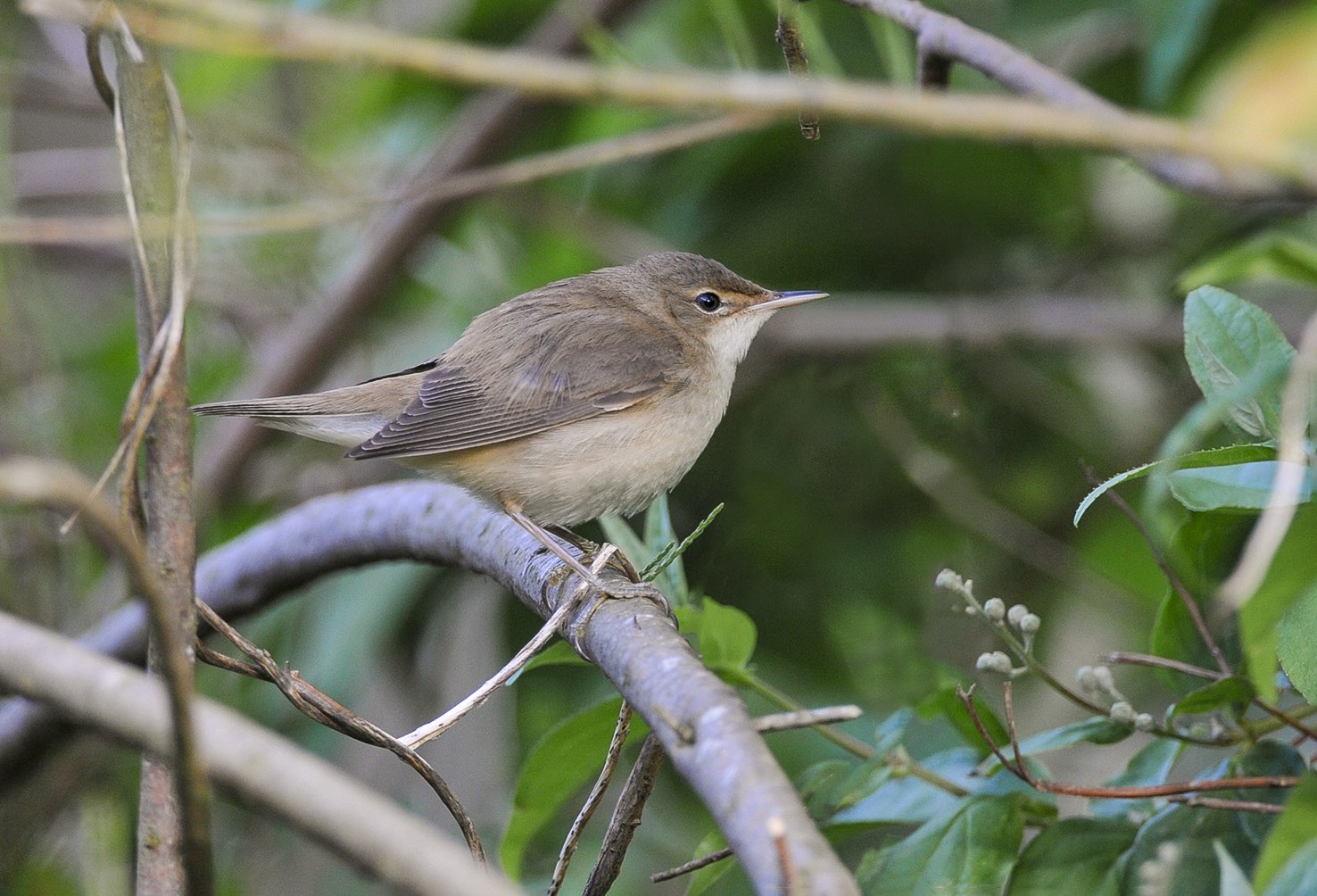
Eurasian Reed Warbler Acrocephalus scirpaceus Texel, Noord-Holland, Netherlands, 7 June 2015 (René Pop).
Eurasian Reed Warbler
In the illustrious company of Marsh Warbler and Blyth’s Reed Warbler, the song of Eurasian Reed Warbler seems very modest indeed. It has little of the dynamism and brilliant mimicry of Marsh, nor the musicality of Blyth’s Reed. Indeed, one of the best ways to recognise Eurasian Reed’s song is its sheer monotony as it just bonks steadily away.
In Britain I’ve spent quite a lot of time explaining the differences between Eurasian Reed Warbler and Sedge Warbler A schoenobaenus song to novices over the years. Many seem to find it helpful when I say they embody reason and passion. Sedge is higher pitched and more excitable than Reed, surging in great waves of passion accompanied by song flights. Meanwhile, Reed’s song to me is like your conscience and as steady as your reason. Musically it’s as regular and predictable as the gorilla’s drum solo in Phil Collins’ In the air tonight.
As always when you listen with more care, bonking away is a bit unkind, and that isn’t quite how it works in practice. Eurasian Reed Warblers make their songs from around 200 discrete units a minute delivered at 3-4 per second. The units are seldom just a single, simple sound, but more often a rapidly doubled harsh sound, a short rattle, a whine, two contrasting sounds one immediately following the other, etc. These are essentially brief units of repetition, and each one is repeated on an average of three times. Two, three or four repetitions are usual, but anything from one to eight can be expected. A change from one set of repeated units to the next takes place on average just over once a second.
Eurasian Reed Warbler Acrocephalus scirpaceus Nieuwedijk, Utrecht, Netherlands, 03:58, 10 June 2011 (Arnoud B van den Berg). Typical song at close range just before 04:00 in the morning. Background: Greylag Goose Anser anser, Common Cuckoo Cuculus canorus and Common Reed Bunting Emberiza schoeniclus. 110610.AB.035800.01
In being made up of thrice repeated motifs, Eurasian Reed Warbler’s song could be compared to that of a Song Thrush Turdus philomelos. But why does it strike us as so much less beautiful? Apart from its monotonous pace, contrasting with the more dramatic rhythms of Song Thrushes, much of this is due to the timbre of the song. As a species that spends most of its life in dense vegetation, Eurasian Reed needs to sing songs that propagate in an environment where most passerine songs would be muffled and lost. Think about it. Reedbeds are challenging acoustic surroundings, where higher frequency sounds (smaller wavelengths) bounce off vegetation, and swishing reeds will mask short and varied sounds. Are there any birds that sing low down in the reeds and have intricate, melodic songs? No, this is the world of booming Eurasian Bitterns Botaurus stellaris and Little Bitterns Ixobrychus minutus, similarly low-pitched and repetitive Common Cuckoos Cuculus canorus and ultra-monotonous Savi’s Warblers Locustella luscinioides, not to mention lots of frogs. Eurasian Reed adapt to this environment in the same ways as the other creatures, by building a lot of redundancy or repetition into their songs, and by singing at as low a pitch as their small body can manage. Perhaps most strikingly, they prefer harsh, guttural, churring sounds. Such sounds cover a wide frequency range, employing many wavelengths at the same time, making it likely that at least some part of each sound will penetrate the stalks and blades of the reedbed.
Eurasian Reed Warbler Acrocephalus scirpaceus Polgár, Northern Great Plain, Hungary, 04:13, 11 May 2019 (Magnus Robb). Song of several males in a ditch. Background: Greylag Goose Anser anser, Eurasian Bittern Botaurus stellaris, Little Bittern Ixobrychus minutus, Black-crowned Night Heron Nycticorax nycticorax and Common Cuckoo Cuculus canorus. 190511.MR.041337.01
Eurasian Reed Warbler Acrocephalus scirpaceus Zwanenwater, Noord-Holland, Netherlands, 08:39, 22 May 2018 (Arnoud B van den Berg). Song full of imitations, eg, Eurasian Blue Tit Cyanistes caeruleus (0:03-0:12), Common Buzzard Buteo buteo (0:13-0:26), Bearded Reedling Panurus biarmicus (0:31-0:32 & 0:38-0:47), Common Blackbird Turdus merula (0:51-0:56) and Sedge Warbler A schoenobaenus (1:01-1:02, 1:08). Background: Greylag Goose Anser anser, Willow Warbler Phylloscopus trochilus and Eurasian Wren Troglodytes troglodytes. 180522.AB.083908.11
Talking of Africa, the taxonomy of reed warblers recently took a surprising twist. It started with the realisation that non-migratory reed warblers in Morocco have shorter wings and a different moult strategy (Amezian et al 2010). This led to the discovery that those birds are genetically distinct from Eurasian Reed Warblers and that migratory reed warblers breeding in most of Iberia belong to the same population (Olsson et al 2016). So, is this Ibero-Maghreb reed warbler more closely related to African Reed Warbler A baeticatus, which breeds as close as Senegal, or to European Reed? The question proved difficult to answer, so when the old name ambiguus was resurrected for this population, nobody argued against it. Concensus is leaning towards including this population in African Reed (eg, IOC World Bird List v 11.1, Clements checklist update 2019) giving many of us an armchair tick but causing enormous headaches in the identification department.
Magnus has had a go at separating songs of Eurasian (A s scirpaceus) and Ambiguous Reed Warblers (A b ambiguus), finding it extremely challenging. To all intents and purposes, they sound the same. Being unable to hear any difference at all at first, he started measuring song units per minute, rate of change of the song units, etc using a sample of songs of several individuals of each. In each measurement it soon became clear that there was much overlap between the two populations. The only slightly promising if ambiguous lead for further research is that by ear, the units in Ambiguous Reed Warbler song seem slightly shorter, without this affecting their speed of delivery, giving the song a slightly more choppy, ‘staccato’ flavour.
Ambiguous Reed Warbler Acrocephalus baeticatus ambiguus Dhyria, Oued Loukkos, Larache, Rharb, Morocco, 07:29, 8 June 2010 (Arnoud B van den Berg). Song. Background: Zitting Cisticola Cisticola juncidis. 100608.AB.072900.01
One day when he has measured a large enough sample of both species, checking the relative proportion of sound versus silence in the song, he expects that Eurasian Reed will have longer units and shorter gaps than African Reed, but only by a whisker. Another, even bigger job for his to do list is to count repertoire sizes, cataloguing all the slightly different types of units in the songs of both. Who knows, perhaps one will have a significantly larger repertoire than the other. We already know that non-migratory ‘Acros’ in Africa have much smaller repertories than intercontinental migrants like Eurasian Reed and Marsh Warbler. Being only a partial migrant, might ambiguus also have a smaller repertoire? For now, we can say that the songs have so far proven to be inseparable, and what we have written above about how to recognise Eurasian Reed song can safely be applied to Ambiguous Reed Warbler as well.
It’s frustrating to do the analysis and not find anything and I had to twist Magnus’s arm to get him to persevere on this subject. In the end, he has contributed more on all of these warblers than me. At the time of writing, we are both stuck inside waiting for the corona pandemic to end, and spring has started. Common Blackbird T merula and Song Thrush both had a good go this morning in my garden. I don’t think the gradual change in day length has so much to do with it either. It has been terribly cold here until today and now suddenly it’s mild and bingo: bird song.
As we have shown above, confident separation of Marsh Warbler, Blyth’s Reed Warbler and Eurasian Reed Warbler is possible just with their songs. I have occasionally found vagrants of the next two, Melodious Warbler H polyglotta and Icterine Warbler, over the years, but the experience is never very satisfactory. Melodious in August disappear for hours and don’t make a sound as they feed on blackberries deep inside impenetrable thickets. So you’ll understand why I’d prefer to find a spring bird singing. Indeed, I would dearly love to find either of them singing in spring. So I get my exceptionally long zoom stick and poke Magnus again to help me with Melodious and Icterine. After all, he will get singing Melodious on his doorstep in Portugal, and Arnoud will have Icterine singing from hedgerows not so far away from his in Holland. Let’s start again with Killian and Richard‘s beautiful illustrations of both.
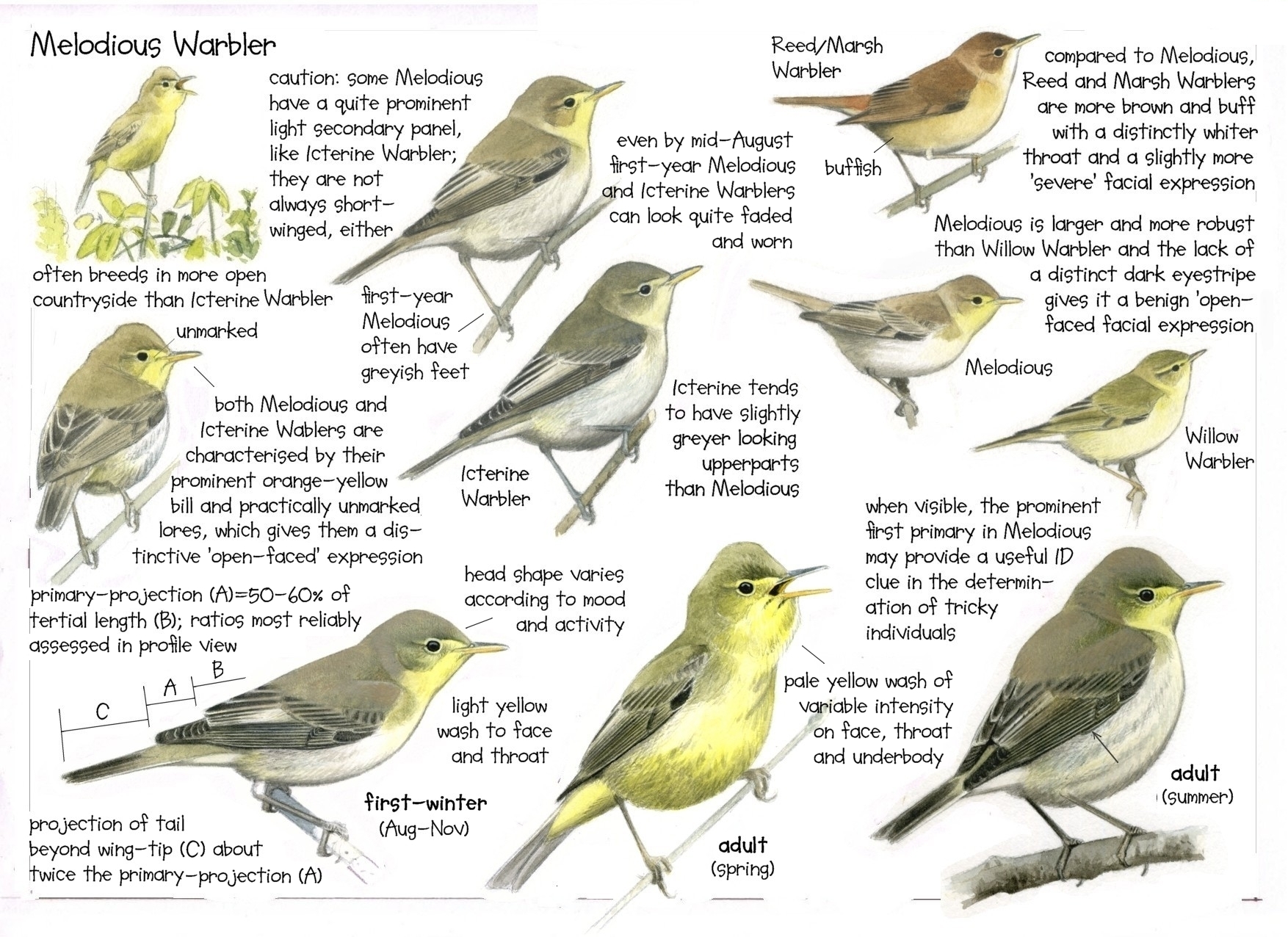
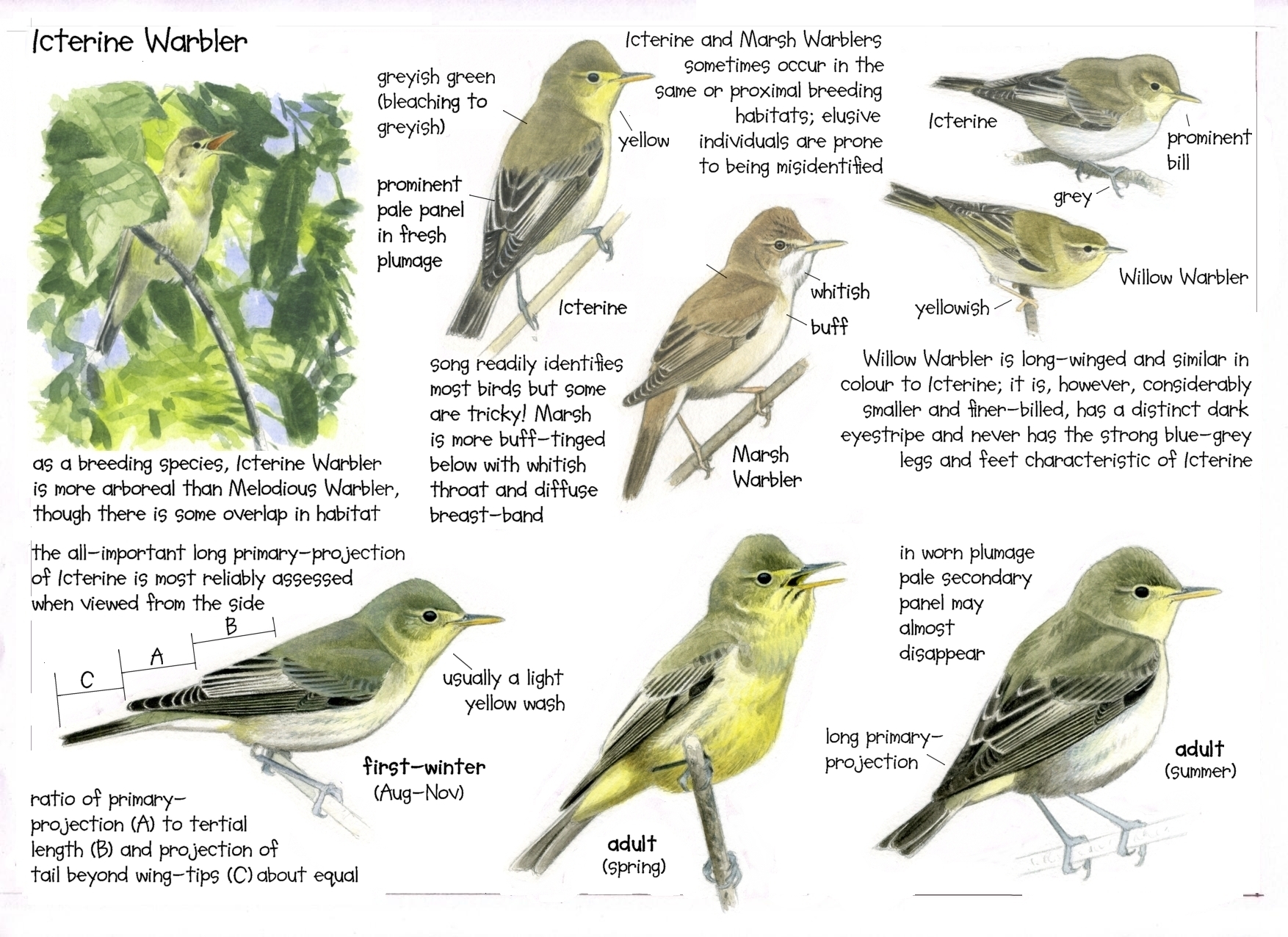
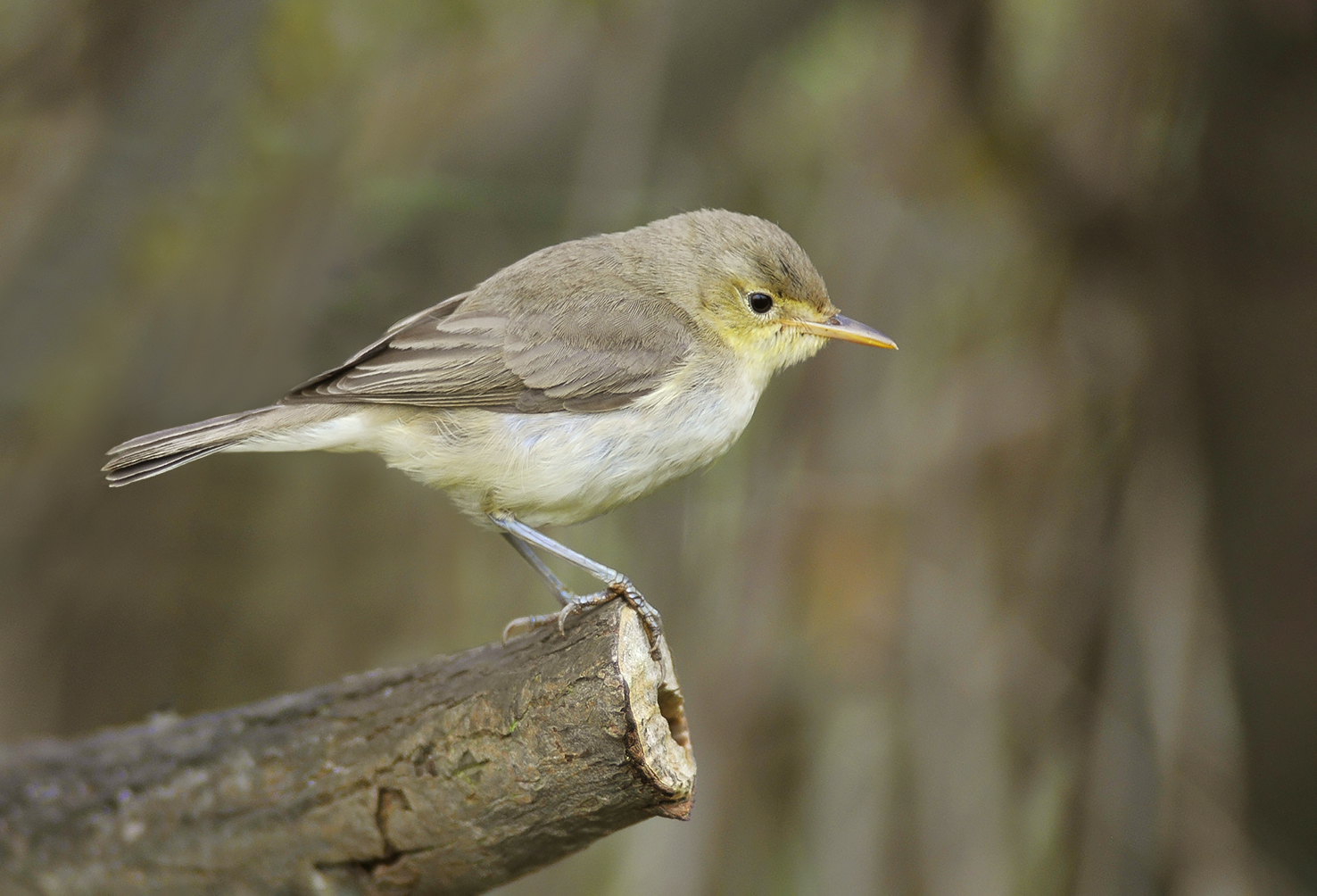
Melodious Warbler Hippolais polyglotta Texel, Noord-Holland, Netherlands, 6 October 2008 (René Pop).
Melodious Warbler
There are two main ways to identify the song of Melodious Warbler, or any other species for that matter. One of those is immediate and instinctive. You listen to the general moment-to-moment texture of the song, alert for any peculiar sounds or features that attract your attention. This is like a ‘jizz’ approach to sound identification. The other is more analytical, requiring attention with a longer time-span, working out how the variation in the song is organised. You could compare it to analysing the structure of a bird, its primary projection, how many feathers in the tail etc. With luck, the first approach may send us in the right general direction, but the second is likely to lead to a more solid conclusion.
In the case of Melodious Warbler, one of the first things that strikes us is that this is an incredibly fast and furious song. With its moderately harsh sounds, a few squeaky notes and a scattering of whistles it sounds a bit like a Sylvia warbler that ended up in the wrong genus. If you are more familiar with Icterine Warbler song, it can sound as if Melodious has three notes for every one of Icterine. One feature that surely helps to create this impression is that Melodious embeds lots of little contact calls in the middle of its strophes, and other sounds that resemble them. Their contact call is a soft, rippling prrr, with three or sometimes four separate elements. If you are in the company of a family with fledged young, you will hear this call every time an adult is approaching the brood, and often the young respond with it too. We haven’t yet recorded a juvenile Melodious Warbler subsong but have heard them giving loosely connected sequences of variations of this call and wouldn’t be surprised if this develops into song. While the embedded contact calls are hardly conspicuous, much of the micro-texture of Melodious song is made up of sounds that ripple or churr in a similar way.
Melodious Warbler Hippolais polyglotta Cabriz, Sintra, Portugal, 10:03, 1 May 2020 (Magnus Robb). Song with embedded contact calls. Background: Zitting Cisticola Cisticola juncidis, Eurasian Blackcap Sylvia atricapilla and Corn Bunting Emberiza calandra. 200501.MR.100304.01
Melodious Warbler Hippolais polyglotta Cabriz, Sintra, Portugal, 09:21, 13 July 2020 (Magnus Robb). Contact calls of a juvenile. Background: Pallid Swift Apus pallidus, Short-toed Treecreeper Certhia brachydactyla and European Goldfinch Carduelis carduelis. 200713.MR.092130.02
Assuming you are hearing the right kind of texture for a Melodious Warbler, what should you listen for next? Strophes can be anything from about five seconds to well over a minute long. At the simplest level, there is a two-part structure. The first part of each strophe consists of rapid repetitions of a single sound, such as the chirp of a House Sparrow Passer domesticus or the disyllabic alarm call of a Barn Swallow, or it may be a little more complex. There may be sparrow alarm calls embedded in among the chirps, or several introductions one after the other, eg, a series of House Sparrow chirps followed by a series of Barn Swallow alarms and then a few Ring-necked Parakeet Psittacula krameri flight calls, with some degree of alternation between the three. At the simplest extreme, the entire first part may be just three repetitions of a sound totalling one second; at the other, there may be several long series of repetitions adding up to nearly a minute. At the end of the first part, there will be a single new permutation of whatever sound has been repeated last, and this is the sign that we are going into the second part.
Melodious Warbler Hippolais polyglotta Cabriz, Sintra, Portugal, 06:41, 28 May 2020 (Magnus Robb). Songs with a variety of different introductions, both in terms of their length and the sound or imitation being repeated. Background: Zitting Cisticola Cisticola juncidis, Common Linnet Linaria cannabina and Corn Bunting Emberiza calandra. 200528.MR.064144.01
What follows is the fast, furious, incredibly intense and usually longer second part of the song. At first there may seem to be endless variety. You may not recognise any mimicry, because each sound is so brief, but we believe it probably consists entirely of plagiarised fragments, micro-mimicry only recognisable as such when we tease it all apart on a computer. It is challenging to discern any order in this seemingly chaotic sequence, but worth the effort. When we stand back and listen on a slightly broader time scale, patterns emerge. The most important is that this second part of the song is largely made up of repeating cycles, or what we have been calling ‘broken record’ chunks. These may not be obvious at first, but then you start noticing certain striking sounds returning at regular intervals. If you look out for this pattern, you’ll soon realise that hardly a single song lacks it on one scale or another. In this sonagram the first part of the song is missing, and the entire 15 second strophe consists of repetitions of just 3 seconds of material (chunks A, B and C).
Melodious Warbler Hippolais polyglotta Cabriz, Sintra, Portugal, 06:41, 28 May 2020 (Magnus Robb). Another section of the same recording from the previous sonagram, with some striking repeated cycles in the latter part of several of the songs. For example, 0:09-0:12 (two and a half cycles), 0:18-0:32 (see sonagram above), 1:04-1:06 (three cycles), 1:27-1:31 (almost two cycles). Background: Sardinian Warbler Sylvia melanocephala, Common Linnet Linaria cannabina and Corn Bunting Emberiza calandra. 200528.MR.064144.01
Repeated chunks may be anything from less than a second to over four seconds long. What often happens is that at first there are one or two short repetitions of a shorter chunk, followed by a different repetition of a much longer chunk. There may be a part of the song, typically the start of the second section, where no repeating pattern can be discerned, but sooner or later the singer will get into a rut. In extreme cases a single chunk may be repeated for 20 seconds or longer. In simpler songs the whole ‘broken record’ part may only involve one and a half repetitions of a chunk. Iterations may differ in one detail or another, but more often than not they contain the same elements in the same order.
Melodious Warbler Hippolais polyglotta Cabriz, Sintra, Portugal, 10:28, 4 June 2020 (Magnus Robb). Ridiculously long strophes with many ‘broken record’ chunks repeated. Background: Eurasian Wren Troglodytes troglodytes and Corn Bunting Emberiza calandra. 200604.MR.102848.02
Often it seems that the only way the bird can get out of the rut is to stop singing, and indeed the song usually ends quite abruptly, often in mid-chunk. Occasionally, however, it ends with a brief third section resembling the first. This is likely to involve repetitions of the same sound that will then be used as an introduction in the next song.
So, how do we tell a singing Melodious Warbler apart from an Icterine Warbler? The most obvious difference concerns the texture and the speed of change of material in the song. Icterine typically repeats each sound a few times in turn, quite conspicuously, whereas Melodious, once it gets past the first section, appears to move from one sound to the next far more rapidly. You have a sporting chance of identifying each imitated species in turn in an Icterine song, whereas with Melodious, once the second section starts you have hardly a hope in hell. And indeed, this dichotomy of first and second sections is conspicuous in Melodious but much harder to find in Icterine. Finally, if you are listening for long ‘broken record’ chunks, there will be more of them in Melodious song, and the average length of the chunks will be greater.
Melodious Warbler is gradually spreading northeastwards into Icterine Warbler territory, and part of the frontier currently lies in Belgium and the southern Netherlands. Melodious Warblers arrive a week or two earlier than Icterines, giving them an advantage which, along with climate change, is helping their northward advance. In this contact zone, Melodious Warblers borrow from Icterines but apparently the reverse is not true (Secondi et al 2003). It is always worth remembering that mixed song does not necessarily coincide with mixed genes. Any apparent ‘mockingbird’ in the Netherlands for example, with an unusually fast song is worth a proper look, as it may well be a bona fide Melodious Warbler.
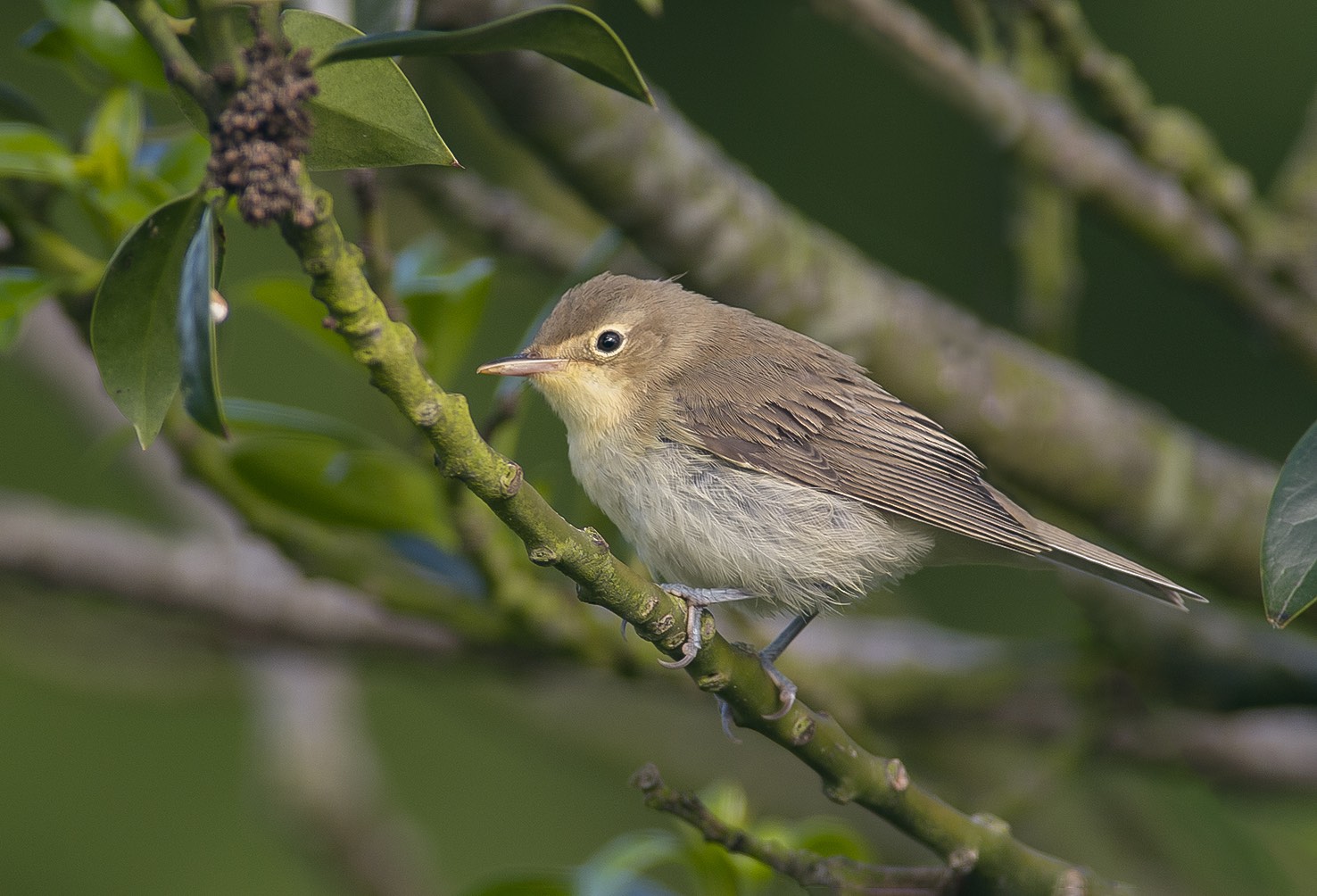
Icterine Warbler Hippolais icterina Texel, Noord-Holland, Netherlands, 20 July 2011 (René Pop).
Icterine Warbler
The key characteristic of Icterine Warbler song that instantly separates it from anything else is its timbre. Icterine has a peculiar ‘squeaky toy’ timbre, due to a very rich presence of harmonics. This is most audible in the longer notes, but looking at sonagrams, more than half of the notes in the song show great piles of harmonics. Not even its closest relative Melodious Warbler has a similar degree of ‘squeakiness’. There are other ways to separate the two species, which are described under Melodious, but timbre is a good place to start. Icterine may have a few whistled notes too that lack the squeaky toy timbre, typically associated with wild twists and turns of pitch, but far more of the song has it than lacks it.
Icterine Warbler song exists in two main structural variants, which may appear in the same bout of singing. In the commonest variant, the strophes are relatively short (mean 7 s, n = 8 individuals) and contain a succession of motifs, each one repeated several times, sometimes with slight variations in rhythm. A motif may consist of a single unit of sound, an imitation in most cases, or two combined into a rhythmic pattern. Sometimes a previous motif is interjected now and then between iterations of a new one. When Magnus analysed songs of 8 individuals he found that a new motif was introduced to the strophe on average once every 1.1 seconds. In those 8 individuals, the mean varied from 0.6 to 1.5 s. This is a rate of variation very similar to a Eurasian Reed Warbler, although Icterine’s song seems far more varied to our ears, because the kinds of sounds used are much more contrasting. Usually there are longer series of repetitions in the first part of each strophe, and towards the end the new motifs appear in slightly quicker succession.
Icterine Warbler Hippolais icterina Hollandse Kade, Utrecht, Netherlands, 04:13, 2 June 2011 (Arnoud B van den Berg). Song with the usual short type of strophes. Note that this individual is singing a duel with another in the distance, and they challenge each other to match strophes. Background: Eurasian Skylark Alauda arvensis. 110602.AB.041300.01
This kind of Icterine Warbler song might be mistaken for a Marsh Warbler, but there are several ways to tell them apart. One is that there are no massive accelerations about 4 times a minute, characteristic of Marsh. Icterine has a relatively stable tempo, though not as steady and monotonous as a Reed Warbler. Secondly there is the squeaky timbre of Icterine. A third thing to listen for is Icterine’s taste in mimicry: Eurasian Oystercatcher Haematopus ostralegus (pi-PEEP, pi-PEEP, pi-PEEP) and two smaller falcons, Common Kestrel Falco tinnunculus and Eurasian Hobby F subbuteo are particular favourites. Differences from Blyth’s Reed Warbler include the squeaky timbre and the faster rate of change of the motifs, with new material typically appearing every second.
Icterine Warbler Hippolais icterina Schiermonnikoog, Groningen, Netherlands, 8 May 2003 (Magnus Robb). Song of a newly arrived male, with imitations including Western Jackdaw Corvus monedula (0:01-0:02), Eurasian Oystercatcher Haematopus ostralegus (0:02-0:03), Common Kestrel Falco tinnunculus (0:03-0:04, 0:14-0:16) and Red-backed Shrike Lanius collurio (0:49-0:50). 03.014.MR.11622.01
In the other, longer type of Icterine Warbler songs, repeating ‘broken record’ chunks may also be embedded, though nearly so often as in Blyth’s Reed Warbler and Melodious Warbler. Longer Icterine songs may be anything from 15 seconds to well over a minute long, and for much of their duration they are structured in a similar way to the shorter strophes. The ‘broken record’-style chunks, when they occur, may be up to 2.5 seconds long, and repeated either exactly or inexactly up to five or six times. In this way they can add considerably to the length of the strophe. While it is far from true that every long strophe has this feature, it is so striking when it occurs that the listener may be taken by surprise, and it is worth mentioning here. This is a feature shared with the other three members of the genus Hippolais, especially Upcher’s Warbler H languida, which takes it to extremes.
Icterine Warbler Hippolais icterina Hollandse Kade, Utrecht, Netherlands, 04:13, 2 June 2011 (Arnoud B van den Berg). Song with the long type of strophes repeating several ‘broken record chunks’. Background: Eurasian Coot Fulica atra and Eurasian Skylark Alauda arvensis. 110602.AB.041300.01
Icterine Warbler is rightly considered one of the top mimics in the Western Palearctic, and its Dutch name Spotvogel translates as ‘mockingbird’. The imitations are often long enough to recognise, and back in 1979, Dowsett-Lemaire noted that the species imitated are basically European, finding no mimicry of African birds at all. Given her vast knowledge of African songs and calls, it would be natural to take her word as gospel. However, we have found at least one instance of an African bird being imitated. Magnus learned the sound of White-throated Bee-eater M albicollis, funnily enough, from a Common Redstart Phoenicurus phoenicurus in Germany while trying to recognise as many imitations as possible in its song. Then in 2019 he had the opportunity to record this bee-eater in Ghana. Its calls are very distinctive, so we can be fairly confident that when we recognise them in an Icterine Warbler song this is no chance resemblance. The Icterine in question was recorded by Arnoud in Holland, and the White-throated Bee-eater is basically a Sahel species, spending the non-breeding season in the rainforest. Our Icterine may have heard it on its journey to southern Africa in our autumn, or the return journey in our spring. With recent WP records in Western Sahara and Israel, this bee-eater’s calls are well worth memorising.
White-throated Bee-eater Merops albicollis Mole National Park, Savannah Region, Ghana, 09:30, 11 November 2019 (Magnus Robb). Calls from a flock perched in a tree. 191111.MR.093052.21
Icterine Warbler Hippolais icterina Hollandse Kade, Utrecht, Netherlands, 04:13, 2 June 2011 (Arnoud B van den Berg). Song with mimicry of White-throated Bee-eater Merops albicollis at the end, then a few seconds later this imitation by itself, artificially singled out. Background: Eurasian Skylark Alauda arvensis. 110602.AB.041300.01
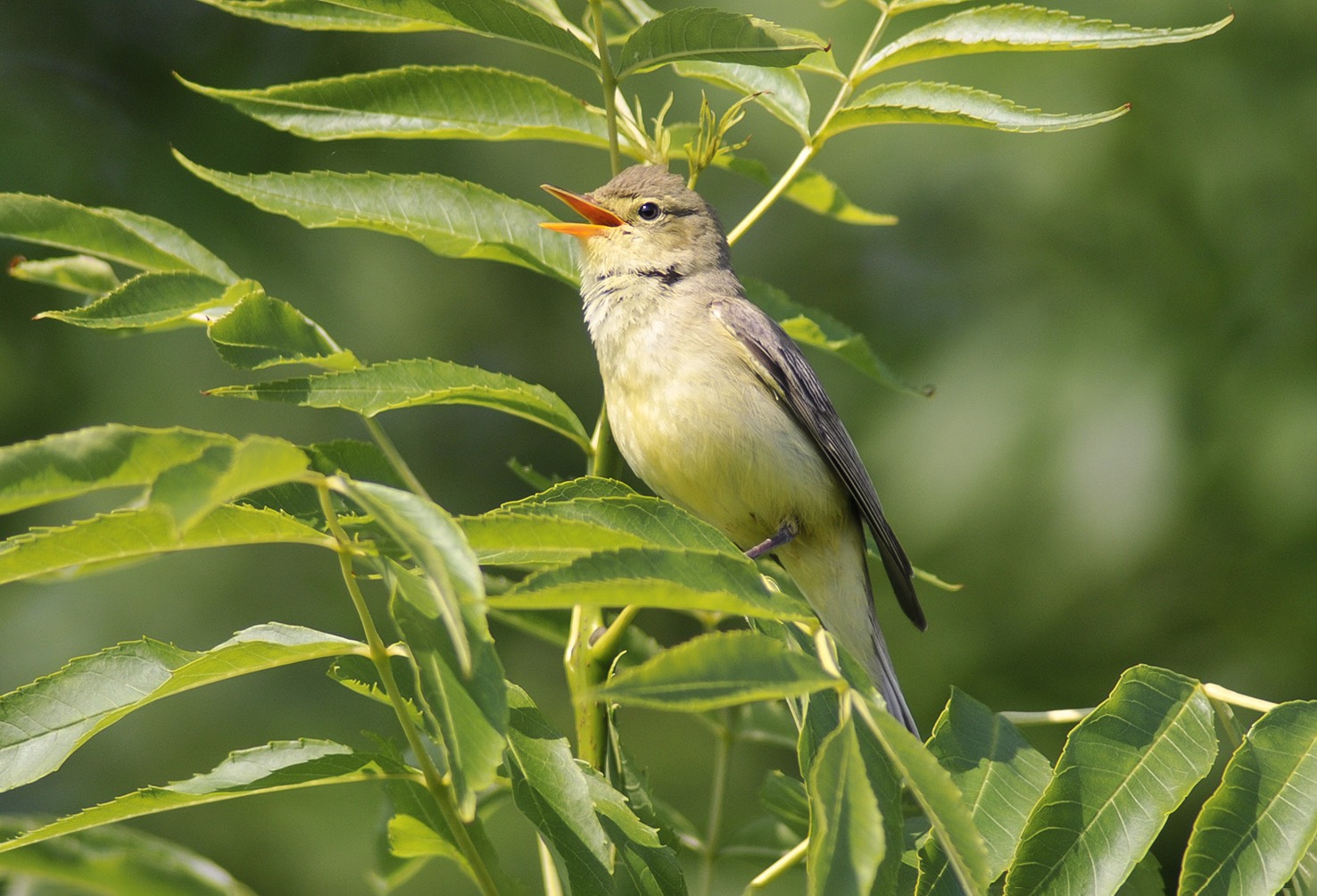
Icterine Warbler Hippolais icterina Texel, Noord-Holland, Netherlands, 6 June 2011 (René Pop).
Other than Eurasian Reed Warbler, if I am to find any of these species in Dorset singing in spring the song is likely to be plastic, since spring overshoots tend to be first-year birds whose songs will only crystallize when they know they have reached their destination and stake out their territory. It is thought that females recognize plastic songs as experimental and avoid interacting with the singers.
Plastic songs of Marsh Warblers still migrating towards their breeding grounds are less clearly structured and it becomes a bit more difficult to discern any regular cycle between faster and slower material in the song. They may include longer sections of frenetic singing than crystallised song, and fewer slow sections with simple repetitions of a single sound or species. Nevertheless, the diagnostic rapid alternations, za wee-style, are all there, and so is the trip report (in progress) for anyone able to follow it!
Marsh Warbler Acrocephalus palustris Göksu Delta, Mersin, Turkey, 15 May 2001 (Magnus Robb). Plastic song of a spring migrant. Background: Wood Sandpiper Tringa glareola, Graceful Prinia Prinia gracilis and Eurasian Reed Warbler A scirpaceus. 01.019.MR.11650.00
Eurasian Reed Warbler’s plastic song is a wonderful thing. Plastic songs by nature lack the steady structure of adult song, they have irregular rhythms, surges and calls interspersed. Not this Eurasian Reed. Its need for tidiness makes it create a steady plastic song, one that causes no inconvenience with everything in the right drawer, just some slight wobbliness and muttering as it goes through its rather steady paces.
Eurasian Reed Warbler Acrocephalus scirpaceus Port de Pollença, Mallorca, Spain, 12:26, 9 May 2016 (Magnus Robb). Song of a spring migrant in an olive tree. Note that Ambiguous Reed Warbler A baeticatus ambiguus arrives early in Iberia and a migrant would be unlikely at this date. However, plastic song of Ambiguous probably sounds extremely similar. Background: Common Nightingale Luscinia megarhynchos and Cetti’s Warbler Cettia cetti. 160509.MR.122606.01
By contrast, Blyth’s Reed Warbler’s plastic song is far more musical and varied, so much so that migrating and breeding males can sound like two different species. This is a bird in a hurry. If you identify Acrocephalus songs only by speed, then Blyth’s plastic song will throw you. They sound as if they are insecure about the size of their repertoire, checking how much they have and hardly pausing to repeat anything in cycles. Remember, the thing that makes the song of Blyth’s on the breeding grounds sound slow and steady is the long cycles and consequent slow repetition rate. With plastic song of migrants, instead of speed, the clues are in the type of sounds the song is made up of, with plenty of short tak-like notes and a variety of more tonal sounds. It may sound as varied as a Marsh Warbler song but lacks the za wee-type motifs and shows far less contrast in terms of velocity within the song. No sudden frenetic outbursts, just a steady variety-check.
Blyth’s Reed Warbler Acrocephalus dumetorum Chokpak pass, Dzhambul, Kazakhstan, 2 May 2000 (Magnus Robb). Plastic song of a spring migrant. Imitations in this song include White-winged Tern Chlidonias leucoptera and Graceful Prinia Prinia gracilis. 00.020.MR.00720.00
The challenge with Icterine Warbler plastic song is a similar one. There are few of the characteristic ‘broken record chunks’ and you have to focus on the timbre and the kinds of species imitated. Their timbre in plastic song is unmistakeably the same ‘squeaky toy’ sound that they use on the breeding grounds, except during those moments when they descend into a kind of whisper song. With this migrant from Greece you can hear some typical imitations, including a Barn Swallow, Eurasian Golden Oriole Oriolus oriolus, Eurasian Hobby, Fieldfare T pilaris and Common Rosefinch Erythrina erythrina (0:37). It’s funny to think that a month or two earlier it was probably imitating rosefinches in South Africa while the very rosefinches it learned the sound from were wintering in India. Of more practical use, any unidentified Hippolais in the UK that is imitating Fieldfare and Common Rosefinch will hardly be an overshooting Melodious Warbler from southwestern Europe, but must be from northeastern Europe and is therefore Icterine.
Icterine Warbler Hippolais icterina Lake Mikri Prespa, West Macedonia, Greece, 7 May 2002 (Magnus Robb). Plastic song of a spring migrant, with imitations including Fieldfare Turdus pilaris and Common Rosefinch Erythrina erythrina. Background: Eurasian Golden Oriole Oriolus oriolus and Common Nightingale Luscinia megarhynchos. 02.023.MR.14516.01
As for Melodious Warbler, we have recordings of its plastic song from Africa. It is a fairly common wintering species in Ghana, and Magnus recorded a couple there in November. Their plastic song is as fast and furious as their song on the breeding grounds but has less clear-cut ‘broken record chunks’, incorporates more rattling contact calls, and occasionally descends into whispered subsong.
Melodious Warbler Hippolais polyglotta Mole National Park, Savannah region, Ghana, 10:01, 16 November 2019 (Magnus Robb). Plastic song of a wintering individual. Background: Vinaceous Dove Streptopelia vinacea. 191116.MR.100102.01
It would be fascinating to know more about the songs of our warblers during the non-breeding season, when they are far away. Are they defending feeding territories or just practicing? Do adults sing as much as first-winter birds? And do they often betray their European origins with mimicry of species from Europe? Magnus heard a Melodious Warbler imitating a Barn Swallow and European Bee-eater M apiaster, for example, but it could have heard those in either continent. More recordings would surely give a clear example or two. Another good excuse to return to Africa, says he.
In your dreams, Magnus!
Amezian, M, Cortes, J, Thompson, I, Bensusan, K, Perez, C, Louah, A, El Agbani, M A & Qninba, A 2010. Complete moult of an undescribed resident taxon of the Reed Warbler Acrocephalus scirpaceus / baeticatus complex in the Smir marshes, northern Morocco. Ardea 98: 225-234.
Dowsett-Lemaire, F 1979. The imitative range of the song of the Marsh Warbler Acrocephalus palustris, with special reference to imitations of African birds. Ibis 121: 453-468.
Olsson, U, Rguibi-Idrissi, H, Copete, J L , Matos, J L A, Provost, P, Amezian, M, Alström, P, Jiguet, F 2016 Mitochondrial phylogeny of the Eurasian/African reed warbler complex (Acrocephalus, Aves). Disagreement between morphological and molecular evidence and cryptic divergence: a case for resurrecting Calamoherpe ambigua, Molecular Phylogenetics and Evolution, doi: http://dx.doi.org/10.1016/j.ympev.2016.05.026
Palmér, S & Boswall, J 1975. A field guide to the bird songs of Britain and Europe 8. Vinyl record and sleeve notes.
Secondi, J, Bretagnolle, V, Compagnon, C & Faivre, B 2003. Species-specific song convergence in a moving hybrid zone between two passerines. Biological Journal of the Linnean Society 80: 507-517.
Svensson, L, Grant, P J, Mullarney, K & Zetterström, D 2009. Collins bird guide. Second edition. London.
Walpole-Bond, J 1933. The Marsh-Warbler as a Sussex species. British Birds 27: 58-65.